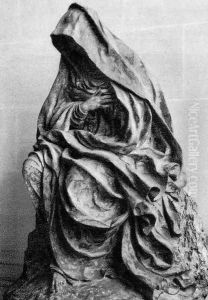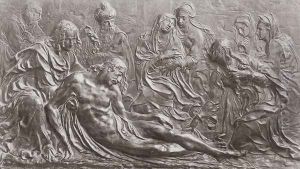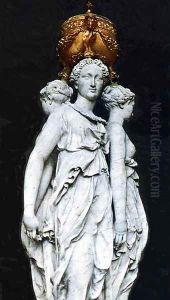Germain Pilon Paintings
Germain Pilon was a French Renaissance sculptor of the late 16th century, renowned for his skill in marble, bronze, and wood sculpture. He was born around 1528 in Paris, France, and is considered one of the most important French sculptors of his time. Pilon's work is characterized by its dynamic forms, intricate details, and expressive figures, which reflect the transition from the Renaissance style to the Baroque.
Pilon's early life and training are not well documented, but it is believed that he came from a family of artists and that his father, Andre Pilon, may have been a stonemason. Germain Pilon's talent became evident in his early works, which garnered the attention of influential patrons. His rise to prominence was marked by his involvement in major projects for the French monarchy.
One of Pilon's most famous works is the tomb of King Henry II of France and his wife, Catherine de' Medici, in the Basilica of Saint-Denis near Paris. He was commissioned to create the effigies and recumbent figures for the tomb, which he executed with remarkable anatomical precision and emotional intensity. Pilon's sculptures for the tomb reflect both the influence of the Italian Renaissance, through the idealized forms, and the burgeoning Baroque style, through the dramatic expression and movement in the figures.
Pilon was also known for his religious sculptures, which were created for various churches in France. His ability to convey the emotional depth of religious scenes and the human form is evident in works such as the 'Descent from the Cross' and the 'Three Graces,' which hold the remains of King Henry II's heart. These works display Pilon's adeptness in working with different materials, as he often combined marble and bronze to achieve contrasting effects.
Throughout his career, Pilon received numerous commissions from the French court and religious institutions, which allowed him to create a diverse body of work that included not only funerary monuments but also altarpieces, decorative sculptures, and small-scale bronzes. His influence extended beyond his lifetime, as his style helped pave the way for the development of Baroque art in France.
Germain Pilon passed away in 1590 in Paris. His artistic legacy is preserved in the numerous sculptures he left behind, many of which are considered masterpieces of French Renaissance art. Pilon's work continues to be studied and admired for its technical mastery, emotional depth, and its pivotal role in the transition between artistic periods.


